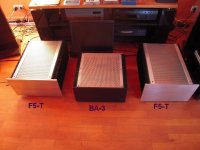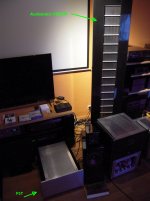It realy no need to go down to 10V on the J-fets. With higher rails in the 40ish Volts i would agree,I suggest sticking with the original value of 4.75K for R27 and R28. That will give
you about 1/3 of the rail voltage across the jfets.
What would be the advantages of the higher voltage? Would it raise the gain of the amp overall?
My mistake: Apparently I couldn't divide 32 by 3. Somehow I thought it was higher. 🙂
There's arguably a bit more linearity with the jfets at a higher voltage. (Obviously
not too high since that's the whole point of the cascode). With 32V rails,
your original 10k should be fine even as long as you're not using V-grade jfets.
There's no change in gain.
There's arguably a bit more linearity with the jfets at a higher voltage. (Obviously
not too high since that's the whole point of the cascode). With 32V rails,
your original 10k should be fine even as long as you're not using V-grade jfets.
There's no change in gain.
Thanks. I'll swap back to the 10K. Getting some desoldering practice. Not a problem if I can get it right.
Testing the PS with the bulb tester. Nothing hooked to the PS output. With the AN-6224 I'm getting 33vdc from Gnd to V+. -33VDC from Gnd to V- and 66 volts from V+ to V-. Is that correct?
The bulb tester acted correctly. When bright for a second then almost off.
The bulb tester acted correctly. When bright for a second then almost off.
You should find when you get biased up your rails will drop a little. 20ga really should be fine at the lengths you're talking about.
Real world use I tend to doubt anything would be changed by going to 18.
Real world use I tend to doubt anything would be changed by going to 18.
sifted through many of these pages, has anyone build a pair of F5-t V3's ? ( thinking about it )
So I've done all of these interconnects in 20ga Dueland wire. Should some of these be a larger gauge? Like the Output and Ground?
On a side note: is there a reason to not turn the middle board by 180 degrees? Shorter and non-crossing wires as a result?
Basically just didn’t think of it. Guess I should have done that and swapped the output boards positions too. Just rotate the whole assembly of the boards.
to jamesvhf #1271
Hello jamesvhf,
I have built F5T -V3-Monoblocks. They run on +-42.8V. Each Monoblock has a 1000 W toroid and some caps....
Excellent poweramps with my electrostatic Loudspeakers (Audiostatic ES300R)!
I use an active crossover for the sub at 80Hz. BA-3 poweramp is driving the subwoofer (JBL 15 inch).
Cheers
Dirk
Hello jamesvhf,
I have built F5T -V3-Monoblocks. They run on +-42.8V. Each Monoblock has a 1000 W toroid and some caps....
Excellent poweramps with my electrostatic Loudspeakers (Audiostatic ES300R)!
I use an active crossover for the sub at 80Hz. BA-3 poweramp is driving the subwoofer (JBL 15 inch).
Cheers
Dirk
Attachments
I You think 45v rails with 625va tx's is enough ?
I have a pair of Brand new Plitron 625va @ 2x30vac
or 3 x 33-0-33 @900va tx's
I have a pair of Brand new Plitron 625va @ 2x30vac
or 3 x 33-0-33 @900va tx's
to jamesvhf #1275
Good morning jamesvhf,
a Plitron with 625 W and sec. AC output of 2x 30V AC will be absolutely enough. (My transformers are also 2 x 30 V AC out)
Rule-of-thumb: multiply your sec. AC V of the toroid with 1.3 to 1.4.
So you will 'land' anywhere between +-39V and +-43V DC after the cap bank.
I have a CRC- filter. It also depends on the values of your resistors between the caps.
Greets
Dirk 😀
Good morning jamesvhf,
a Plitron with 625 W and sec. AC output of 2x 30V AC will be absolutely enough. (My transformers are also 2 x 30 V AC out)
Rule-of-thumb: multiply your sec. AC V of the toroid with 1.3 to 1.4.
So you will 'land' anywhere between +-39V and +-43V DC after the cap bank.
I have a CRC- filter. It also depends on the values of your resistors between the caps.
Greets
Dirk 😀
Very impressive system Dirk. I don't normally associate a Class A with electrostatics due to the power requirements. Or with a sub amp for that matter for the same reason. I'm sure it sounds great. I'm now thinking Honey Badger to power a pair of OB subs to compliment my F5 and F5T that will power my LX-Mini system. This DIY thing never stops, does it? Or I hope it doesn't.
Last edited:
to bullitt5094
Hello bullitt5094,
once you are infected with this 'search-for-the-perfect-sound-virus' it is difficult
to come back to life without that... 🙄
Greets
Dirk 😉
Hello bullitt5094,
once you are infected with this 'search-for-the-perfect-sound-virus' it is difficult
to come back to life without that... 🙄
Greets
Dirk 😉
I believe "Chasing the Dragon" is the proper terminology. But DIY Speaker Design/Construction (never thought I'd own a CNC router) and now Amps has taken that to a whole new level. And this is one of my inexpensive hobbies.
Very impressive system Dirk. I don't normally associate a Class A with electrostatics due to the power requirements. Or with a sub amp for that matter for the same reason. I'm sure it sounds great. I'm now thinking Honey Badger to power a pair of OB subs to compliment my F5 and F5T that will power my LX-Mini system. This DIY thing never stops, does it? Or I hope it doesn't.
in my humble opinion, the honey badger for a sub is just waist of a fantastic amp. Also, a 5 pair slewmaster would do the job better. For sub use you don't need anything more fancy then class D. I use hypex amps for sub use, and 5ch of honey badger for front, center and back (soon to be 7ch of honey badger).
- Home
- Amplifiers
- Pass Labs
- F5Turbo Illustrated Build Guide


